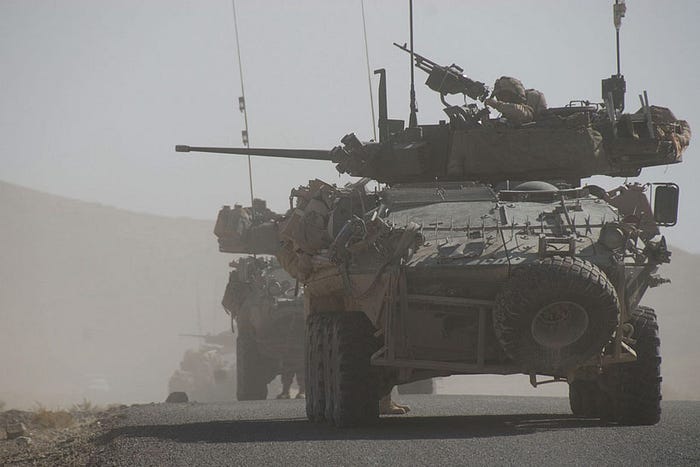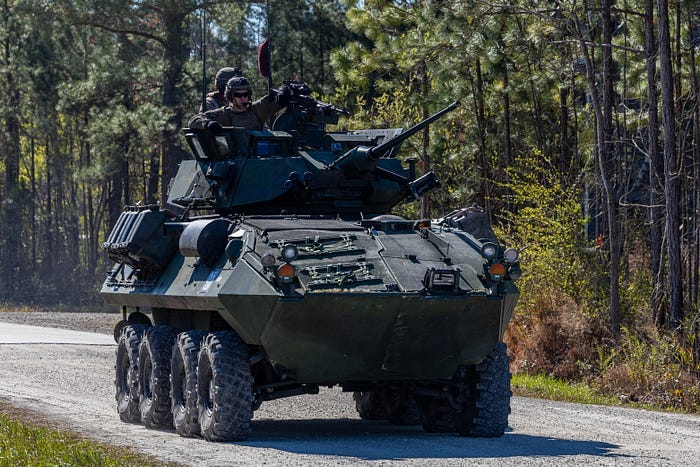Ottawa Keeps ‘Em Rolling: Another $30M in APCs for Ukraine
What the LAV II Bison and Coyote Mean on Ukraine’s Frontlines
Oh, Canada!
Two weeks ago, Canada pledged another $35 million to Ukraine in fresh military aid. Of that, $30 million will go on more armored personnel carriers, the LAV II Bison and Coyote vehicles from General Dynamics Canada, plus ammo and gear.
Canada already shipped 64 Coyotes in December, and now it’s sending replacements and upgrades. The remaining $5 million? Deployed to new electronic-warfare kits designed to counter the Russian jamming on high-tech Ukrainian weapons and comms.
Defense Minister David McGuinty made it official during the 28th Ramstein meeting at NATO HQ. Canada is leaning into industrial mobilization, F-16 pilot training, and, now, ground vehicle support.
This isn’t a drop in the bucket. Since 2022, Canada has funneled nearly $19.5 billion into Ukraine, with $4.5 billion in military hardware. And with this move, Canada is doubling down on mobile, protected capability.
Okay, so what is Ukraine actually getting? Meet the APCs: Bison and Coyote
The LAV II Bison
Born in 1988, when GM Canada wanted to keep production humming, the Bison repurposed the LAV‑25 chassis with a boxy troop compartment and ramp. Six and a half meters long, with eight wheels, and about 13 tons, it carries two crew plus eight passengers.
It can be lined out as a mortar carrier, ambulance, EW van, or command post with rail-mounted modular gear. Upgrades over time included better engines, torsion bars, add-on armor, and NBC filters; it even floats at five knots.
Its C6 pintle-mounted machine gun gives it base-level defense, and variants adapt to battlefield jobs with harpoons, radios, and sensors straight out of a Swiss army kit. It’s been a go-to reserve vehicle since UN missions in Somalia and Yugoslavia in the 1990s, through Afghanistan, and remains reliable thanks to simplicity and modularity.
The LAV II Coyote
The Coyote is a beefier, more modern cousin. Think of this LAV II as the one “with teeth.” Introduced in 1996, it’s also built on the 8x8 LAV‑25 chassis but packed with a 25 mm Bushmaster cannon, coax and pintle machine guns, grenade launchers, and smoke nets. Crew of four, including a turret operator and a surveillance specialist who operates dual radar and video systems.
Sensors include a mast-mounted SURFACE radar and IR/laser optics with a 20 km detection range, giving crews a “see-under-forest” sightline to spot tanks, trucks, or troops far off. With a 660 km range, 275 hp, GPS/nav aid backup, and a hydraulic winch, it’s a reconnaissance powerhouse.
Not a tank, but capable of spotting and calling fires from a distance.
The Bison and Coyote platforms come in several specialized variants to support different battlefield roles. One configuration serves as a mobile command post, giving commanders a protected, forward-positioned hub for coordinating operations.
Another feature is an extendable mast system designed to elevate radar or communications gear while keeping the vehicle concealed, ideal for tactical surveillance and early warning.
A third variant includes a remote sensor suite that can be deployed up to 200 meters away via a cable reel, allowing for discreet monitoring of enemy movements without exposing the vehicle itself.
So why is this exciting? A troop carrier’s just a troop carrier, right?
Not in this case. When you add mast-mounted radar, encrypted comms, modular guts, and wheels tough enough to cruise through eastern Ukraine’s moonscape, you’re looking at more than transportation. You’re looking at a combat amplifier.
Let’s start with the eyes. The Coyote, especially in its surveillance variants, turns terrain into an information network. Ukrainian brigades can now post up behind ridgelines, extend a mast, and scan for Russian convoys, artillery emplacements, or even isolated armor formations up to 24 kilometers out, all while staying invisible. Unlike drones, these sensors can’t be jammed, spoofed, or shot down mid-feed. It’s battlefield recon that persists.
Meanwhile, the Bison rolls in as a mobile Swiss Army knife.
Need a command post on the move? Done.
Mortar carrier? Absolutely.
Field ambulance that won’t get lit up by drone fire? You bet.
In a fight where the front line shifts by the hour, having rolling command-and-control keeps Ukraine’s combined arms coordinated, whether it’s FPV swarms, T-64s, or HIMARS in the mix.
And let’s not forget the obvious: moving through contested terrain without getting shredded is a luxury.
With Strelas in trees, loitering Lancets overhead, and mines in every roadside ditch, protected movement is no longer optional. These vehicles don’t just carry troops, they get them there alive. That’s force preservation.
Last but not least, this is a flex from Canada. By shipping LAV IIs and then ramping up domestic industry to support spares, upgrades, and electronic warfare kits, Canada is tying its defense economy to Ukraine’s long-term war effort. That’s smart politics and smarter strategy. It’s really about keeping Ukraine ready for whatever comes next.
Coyotes in Ukrainian hands mean faster recon loops, full stop.
Instead of waiting for a drone feed or hoping for a cloud-free satellite pass, commanders can get 360-degree situational awareness from a radar mast planted behind a ridge. That kind of persistent, local intelligence means units aren’t guessing… they’re reacting in real time, and that changes everything from patrol routes to kill boxes.
Bison command post variants push the command chain forward, literally. Brigade and battalion-level leaders can now ride just behind the line of contact, issuing course corrections on the fly, synchronizing fire missions, and collapsing the time it takes to go from spotting a Russian mortar battery to sending it to hell.
In a war of seconds, this is a logistical adrenaline shot.
The mortar and medevac Bison variants bring a degree of operational flexibility that has been missing. Now, units can lay down indirect fire support from behind cover, yank wounded out without relying on soft-skin trucks, and run quick maintenance ops, all without waiting on vulnerable convoys.
That’s resilience in motion, and it shortens the tail while sharpening the spear.
Then there’s electronic warfare. Combine the Bison’s modular interior with Canada’s $5 million investment in jamming kits, and you suddenly have rolling EW nodes in the field.
These can either protect loitering munitions from being spoofed or disrupt incoming Shaheds before they can find their mark. Either way, it creates a protective bubble around high-value assets, which is exactly what Ukraine needs more of.
Finally, Canada is already deep in F-16 pilot training, and now it’s layering in ground-mobile ISR, comms, and EW platforms. The message? Start integrating combined arms the way NATO does. These vehicles are a training tool, helping Ukrainian forces to think more like a 21st-century army, doctrinally.
The Most Exciting Part is How the Coyote Speeds Up the Kill Chain
In the Ukraine War, whoever sees first, shoots first. The Coyote doesn’t shoot hypersonics or drop JDAMs, but it’s a battlefield whisperer, a sensor-laden scout that fast-tracks kill chains.
Coyotes with remote surveillance suites bring eyes to the fight without sticking their necks out. These variants can deploy their radar and EO/IR sensor packs up to 200 meters away, meaning the vehicle itself stays tucked behind cover.
You’re not exposing the whole platform just to get a look. Drop the gear, stay hidden, and let the sensors do the peeking. Once a target shows up, the clock starts ticking — and not in their favor.
Then there’s the mast variant. In flat, open terrain where line-of-sight is life or death, a 10-meter-high sensor suite is gold. While drones can be jammed, tracked, or shot down, a ground-planted MSTAR radar doesn’t care. It sits there tracking targets out to 24 kilometers.
That gives Ukrainian fire controllers a generous window to queue up HIMARS, Excalibur, or even FPVs, long before the Russians realize they’ve been spotted.
But these platforms don’t just see, they talk. Once a Coyote crew detects a Russian armor column or a dug-in artillery nest, they can package that intel, GPS-tagged, real-time targeting data, and fire it off to frontline units via Ukraine’s Delta command-and-control system or even a Starlink uplink.
It’s battlefield fast-tracking: from “there they are” to “there they were” in minutes.
Coyotes also come with some baked-in battlefield insurance. Each vehicle includes GPS, a digital compass, and dead-reckoning systems. So, if Russia spoofs GPS signals or wipes the satlink, these platforms still know exactly where they are. And more importantly, where the enemy is. That precision makes all the difference when indirect fire needs to land in a five-meter box, not a field 400 meters away.
Coyotes are built for role clarity. Unlike other recon vehicles where the gunner, driver, and scout are all swapping hats mid-mission, these platforms carry a dedicated surveillance operator. One job: watch the sensors, ID threats, and feed coordinates to whoever needs them.
That division of labor means decisions happen faster, comms stay clean, and targets don’t get a second chance.
Ukraine doesn’t need exact copies of every NATO asset; it needs systems that plug into its doctrine and multiply impact.
The Bison and Coyote do exactly that: flexible, mobile, protected, sensor-infused… ready for a fight defined by drones, artillery, and rapid movement.
Canada’s yet another signal of belief in that fight: ground mobility, scalable tech, and industrial longevity. Another $4 billion from partners this year alone is not charity, it’s strategic backing.
Sending weapons isn’t enough. Support must be layered, long-term, and tactical. Bison and Coyote help flip the equation.
Thanks to Canada for continuing its support of Ukraine and co-producing the win.
Слава Україні!






Great reporting as always! And great news for Canada, a good friend of Ukraine and democracy.
As you put it, Crimea is Ukraine. Heroyim Slava!
One of few good things trump is responsible form is the election of PM Mark Carney, a strong supporter of Europe and Ukraine.